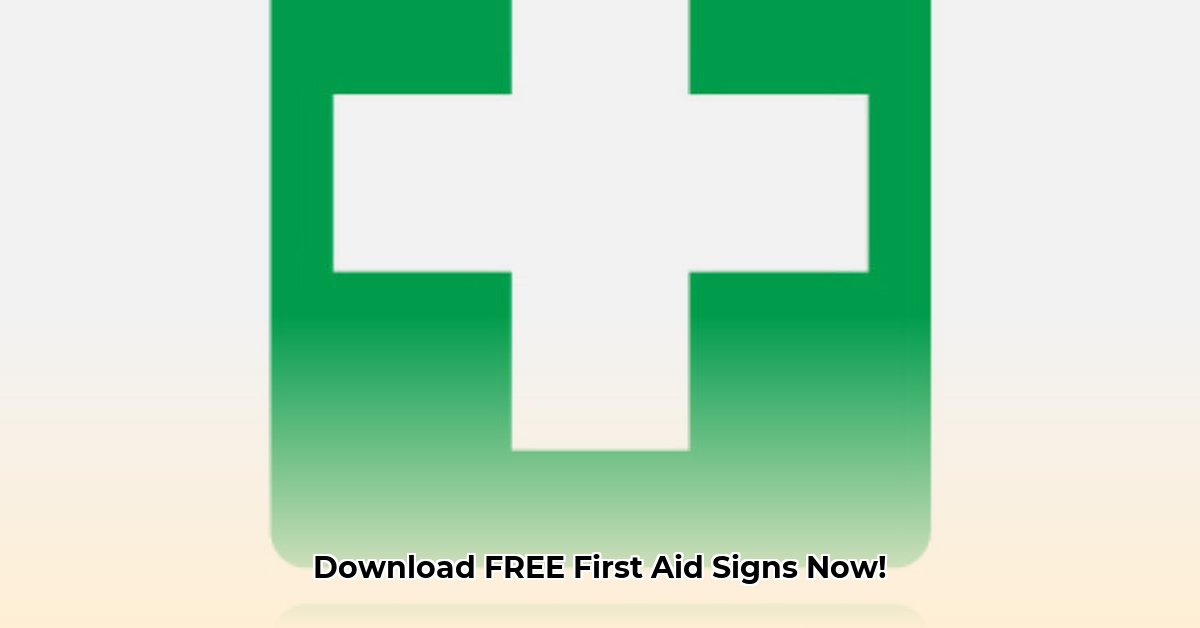Worried about workplace safety? Knowing where the first-aid kit is can be the difference between a minor scrape and a major problem. This guide shows you how to create (or choose) clear, easy-to-understand first-aid signs that meet all the rules and regulations. We’ll walk you through everything from design and placement to keeping your signs in top shape. Learn how well-placed signs protect your employees, visitors, and even first responders – and discover simple steps to ensure your workplace is compliant and safe. Let’s work together to make your workplace safer and better prepared. For additional supplies, check out our selection of first-aid bags.
First Aid Sign: Your Workplace Safety Lifeline
Ready to boost your workplace safety game with optimized workplace safety solutions? Let’s talk about first aid signs – they’re more than just pretty pictures; they’re lifelines in emergencies. Clear, easy-to-see signs mean quicker responses and, ultimately, safer workplaces. This isn’t just about ticking boxes; it’s about protecting people with better emergency preparedness. First aid signs are a critical component of any comprehensive safety program, acting as visual cues that guide individuals to necessary medical resources during crises. Their effectiveness hinges on visibility, clarity, and adherence to recognized standards.
Navigating the Legal Landscape
Before you even think about designing your signs, let’s cover the legal ground with OSHA compliance. Organizations like OSHA (Occupational Safety and Health Administration) and ANSI (American National Standards Institute) set the standards. They dictate things like sign size, colors, symbols, and where they should go. Ignoring these rules can lead to some serious fines, so it’s worth taking the time to understand them for workplace regulations. And don’t forget to check your local regulations – they might have extra requirements regarding safety signage requirements. Understanding and adhering to OSHA 29 CFR 1910.145, which covers specifications for accident prevention signs and tags, is paramount. This standard details the design, application, and use of signs or symbols indicating and defining specific hazards that could lead to accidental injury or property damage.
Designing First Aid Signs That Really Work
Creating effective first aid signs isn’t just about tossing a green cross on a background. It’s about careful planning of first aid sign design. Here’s a step-by-step guide:
- Symbol Selection: The iconic green cross on a white background is universally understood as “first aid.” Stick with it – it’s simple and effective. No need to reinvent the wheel! The International Organization for Standardization (ISO) also provides guidance on symbols for safety signs, ensuring global recognition and comprehension.
- Sizing Up Your Signs: Make sure your signs are big enough to be seen from a distance. Think about how far away people might be when they need to see them. OSHA guidelines offer a good starting point for sizing, but common sense should prevail for visual communication. The American National Standards Institute (ANSI) provides detailed guidelines on sign size based on viewing distance, ensuring readability in various environments.
- Crystal Clear Messaging: Keep the text short, sweet, and to the point. “First Aid” usually does the trick. No need for complicated jargon – clarity is king with effective communication strategies. Use simple, direct language that is easily understood by individuals with varying levels of literacy.
- High-Contrast Colors: Choose colors that pop! The goal is to make the sign easily noticeable from afar, even in less-than-ideal lighting conditions. Think about how your eyes are naturally drawn to contrast for visual accessibility. According to ANSI Z535.1, safety colors should be used consistently, with green designating safety-related equipment and first aid.
- Built to Last: Select durable materials that can stand up to everyday wear and tear. If your signs are outdoors, you’ll need materials suitable for weather exposure. Think about how long you want the signs to last. The cost of replacement is a factor regarding durable signage solutions! Consider materials like aluminum, acrylic, or durable plastics for longevity, especially in harsh environments.
- Accessibility for All: Let’s make sure everyone can see your signs. Include tactile indicators and Braille for people with visual impairments. It’s the right thing to do, and it’s often legally required, ensuring ADA compliance signage. Comply with the Americans with Disabilities Act (ADA) Standards for Accessible Design, which specifies requirements for tactile signs, including Braille and raised characters.
Smart Placement: Maximizing Visibility
Where you place your signs matters just as much as how you design them concerning strategic sign placement. Consider these key factors for workplace safety best practices:
- Prime Visibility: Place signs where they’re easily seen. Avoid cluttered areas or spots that are obstructed from view. Think about common sightlines to aid wayfinding solutions. Conduct a visibility study to determine optimal locations for signs, considering factors like lighting, viewing angles, and potential obstructions.
- Easy Access: Keep the signs readily accessible along main walkways and in high-traffic zones. Don’t hide them away – make them easy to find. Ensure that signs are positioned along accessible routes, complying with ADA guidelines for clear floor space and reach ranges.
- Strategic Positioning: Consider placing signs near potential hazards, in high-traffic areas, and near entrances and exits. Conduct a hazard assessment to identify areas where first aid signage is most critical.
- Multiple Signs are Your Friends: In larger workplaces, using several strategically placed signs improves the likelihood that someone will see one when they need it. Implement a signage plan that includes multiple signs at key locations throughout the facility, ensuring comprehensive coverage.
Keeping Your Signs in Top Shape
Regular maintenance keeps your safety messages clear and effective through proper sign maintenance protocols.
- Regular Inspections: Frequently check your signs for damage, fading, or deterioration. A quick weekly check is highly recommended. Implement a routine inspection schedule, documenting the condition of each sign and any maintenance performed.
- Swift Repairs/Replacements: Don’t wait – fix or replace damaged signs immediately. A damaged sign can be worse than no sign at all offering proactive safety measures. Maintain a supply of replacement signs and hardware to facilitate quick repairs and replacements.
- A Little TLC: Keep your signs clean and free from obstructions. A quick wipe-down can make a big difference by ensuring clear safety communication. Establish a cleaning schedule to regularly wipe down signs, removing dust, dirt, and other contaminants.
Going the Extra Mile: Beyond the Basics
Meeting minimum requirements is a good start, but consider adding extra information to make your signs even more helpful with enhanced emergency response.
- Clear Directions: Include clear directions to your first aid station. Simple arrows and concise language are key. Incorporate directional arrows and distance indicators to guide individuals to the nearest first aid station.
- Emergency Contacts: List both internal and external emergency contact numbers. Think about who needs to be notified during an emergency. Include a list of emergency contact numbers, including internal personnel and external emergency services.
- AED Location (if applicable): If you have an Automated External Defibrillator (AED), clearly mark its location on your signs. This is critical for cardiac emergencies, promoting emergency preparedness. Use the universally recognized AED symbol and clear text to indicate the location of AED devices.
Your first aid signs aren’t just signs; they are a vital part of your overall safety plan. Taking the time to create and maintain clear, effective signage shows your commitment to employee and visitor well-being, highlighting corporate social responsibility. Don’t underestimate their life-saving potential. Remember to train employees on the meaning of the signs and the location of first aid resources to create a culture of safety and preparedness.
How to Ensure ADA Compliance for Workplace First Aid Signage
Key Takeaways:
- Understanding ADA compliance is crucial for workplace safety and legal protection, including legal compliance.
- Properly designed and placed first aid signage saves lives and prevents legal issues, offering effective emergency response.
- Accessible signage benefits everyone, improves workplace culture, and fosters inclusivity, promoting inclusive design.
- Simple steps can significantly improve your workplace’s ADA compliance related to first aid, ensuring universal accessibility.
Understanding ADA Requirements for First Aid Signs
First aid signage isn’t just about pointing to a box; it’s about ensuring everyone can quickly find help. Think about it – wouldn’t you want clear instructions in an emergency for emergency wayfinding? How to ensure ADA compliance for workplace first aid signage starts with grasping the Americans with Disabilities Act (ADA) standards. These standards ensure your signs are accessible to everyone, regardless of ability. According to the Americans with Disabilities Act (ADA), businesses must provide reasonable accommodations to individuals with disabilities. The ADA Standards for Accessible Design, specifically sections related to signage (such as 703.5 for tactile characters and 703.7 for visual characters), dictate the requirements for accessible first aid signage.
Failure to comply isn’t just about fines – it’s about potentially jeopardizing someone’s safety regarding risk management. It’s a matter of responsibility and ethical practice. Let’s dive into those practical steps. Fines for ADA violations can range from $75,000 for the first violation to $150,000 for subsequent violations, demonstrating the importance of compliance.
Step-by-Step Guide to ADA-Compliant First Aid Signage
- Symbol Selection: Use the universally recognized International Symbol of Accessibility (ISA) for accessibility. Think of it as
- Gluten Free Meal Prep Ideas for Delicious, Hassle-Free Eating - November 28, 2025
- Gluten Free Meal Prep for Stress-Free and Healthy Eating - November 27, 2025
- Quick And Easy Chicken Thigh Meal Prep For Weight Loss - November 26, 2025










